Dynamical Analysis of Nutrient-Phytoplankton-Zooplankton Model with Viral Disease in Phytoplankton Species under Atangana-Baleanu-Caputo Derivative
Abstract
:1. Introduction
2. Mathematical Backgrounds
2.1. Basic Definitions
2.2. Some Fixed Point Theorems
2.3. Model Construction
- (i)
- The functions and are continuous defined on ;
- (ii)
- The functions , , , and ;
- (iii)
- The function is the response function representing herbivore grazing where g is continuous on and satisfies , , and , .
2.4. The Equilibrium Points of the - Model (3)
- is the axial equilibrium point and exists for all parameter values;
- is the boundary disease-free equilibrium point and existence assumptions of are and which refers to ;
- is the boundary endemic equilibrium point and existence assumptions of are and which refers to ;
- is the boundary phytoplankton free equilibrium point and existence assumptions of are and which refers to ;
- is the interior equilibrium point and is the positive solution of
3. Existence Criteries for the - Model (3)
3.1. Uniqueness Criterias of the - Model (3)
- there is a positive real number such that
- , , ,
- , , , and , . Denote . If
3.2. Existence Criteria of the - Model (3)
- there is so thatwith .
4. Stability Criterias of the - Model (3)
- Definition 8⇒ Definition 9;
- Definition 10⇒ Definition 11;
- Definition 10 for ⇒ Definition 8.
- , , ;
- , .
- , , ;
- , .
4.1. The Stability
4.2. The Stability
5. Numerical Experiments for the - Model (3)
5.1. Numerical Technique
5.2. Numerical Experiments
6. Conclusions
Author Contributions
Funding
Institutional Review Board Statement
Informed Consent Statement
Data Availability Statement
Acknowledgments
Conflicts of Interest
References
- Kilham, S.S.; Kilham, P. The importance of resource supply rates in determining phytoplankton community structure. In Trophic Interactions Within Aquatic Ecosystems; Meyers, D.G., Strickler, J.R., Eds.; Westview Press Inc.: Boulder, CO, USA, 1984; pp. 7–27. [Google Scholar]
- Smayda, T.J. Species Succession. In The Physiological Ecology of Phytoplankton; Morris, I., Ed.; The University of California Press: Berkeley, CA, USA, 1980; pp. 493–570. [Google Scholar]
- Raymont, J.E.G. Plankton and Productivity in the Oceans; Pergamon Press: London, UK, 1963. [Google Scholar]
- Hecky, R.E.; Kilham, P. Nutrient limitation of phytoplankton in freshwater and marine environments: A review of recent evidence on the effects of enrichment. Limnol. Oceanogr. 1988, 33, 796–822. [Google Scholar] [CrossRef] [Green Version]
- Ryther, J.H.; Dunstan, W.M. Nitrogen, phosphorus, and eutrophication in the coastal marine environment. Science 1971, 171, 1008–1013. [Google Scholar] [CrossRef] [PubMed] [Green Version]
- Lucas, L.V.; Koseff, J.R.; Cloern, J.E.; Monismith, S.G.; Thompson, J.K. Processes governing phytoplankton blooms in estuaries. I. The local production-loss balance. Mar. Ecol. Prog. Ser. 1999, 187, 1–15. [Google Scholar] [CrossRef]
- Berman, T.; Stone, L.; Yacobi, Y.Z.; Kaplan, B.; Schlichter, M.; Nishri, A.; Pollingher, U. Primary production and phytoplankton in Lake Kinneret: A long-term record (1972–1993). Limnol. Oceanogr. 1995, 40, 1064–1076. [Google Scholar] [CrossRef]
- Flynn, K.J.; Fasham, M.J.R.; Hipkin, C.R. Modelling the interactions between ammonium and nitrate uptake in marine phytoplankton. Philosophical Transactions of the Royal Society of London B. Biol. Sci. 1997, 352, 1625–1645. [Google Scholar] [CrossRef]
- Fukuyo, Y.; Takano, H.; Chihara, M.; Matsuoka, K. Red Tide Organisms in Japan-An Illustrated Taxonomic Guide; Uchida Rokakuho, Co., Ltd.: Tokyo, Japan, 1990; p. 401. [Google Scholar]
- Taylor, F.J.R. The species problem and its impact on harmful phytoplankton studies, with emphasis on dinoflagellate morphology. In Toxic Phytoplankton Blooms in the Sea; Smayda, T.J., Shimizu, Y., Eds.; Elsevier: Amsterdam, The Netherlands, 1993; pp. 81–86. [Google Scholar]
- Steidinger, K.A.; Tangen, K. Dinoflagellates. In Identifying Marine Diatoms and Dinoflagellates; Tomas, C.R., Ed.; Academic Press: New York, NY, USA, 1996; pp. 387–598. [Google Scholar]
- Huppert, A.; Blasius, B.; Stone, L. A Model of Phytoplankton Blooms. Am. Nat. 2002, 159, 156–171. [Google Scholar] [CrossRef]
- Singh, B.K.; Chattopadhyay, J.; Sinha, S. The role of virus infection in a simple phytoplankton zooplankton system. J. Biol. 2004, 231, 153–166. [Google Scholar] [CrossRef]
- Chakraborty, S.; Chatterjee, S.; Venturino, E.; Chattopadhyay, J. Recurring Plankton Bloom Dynamics Modeled via Toxin-Producing Phytoplankton. J. Biol. Phys. 2007, 33, 271–290. [Google Scholar] [CrossRef] [Green Version]
- Nath, B.; Roy, P.; Das, K.P. Dynamics of nutrient-phytoplankton-zooplankton interaction in the presence of viral infection. Nonlinear Stud. 2019, 26, 197–217. [Google Scholar]
- Nath, B.; Roy, P.; Sahani, S.K.; Maiti, S.; Das, K.P. Plankton dynamics in nutrient–Phytoplankton–Zooplankton model with viral infection in phytoplankton. Nonlinear Stud. 2020, 27, 1–24. [Google Scholar]
- Rehim, M.; Zhang, Z.; Muhammadhaji, A. Mathematical analysis of a nutrient-plankton system with delay. Springer Plus 2016, 5, 1–22. [Google Scholar] [CrossRef] [PubMed] [Green Version]
- Chakraborty, K.; Dasb, K. Modeling and analysis of a two-zooplankton one-phytoplankton system in the presence of toxicity. Appl. Math. Model. 2015, 39, 1241–1265. [Google Scholar] [CrossRef]
- Wang, Y.; Wang, H.B.; Jiang, W.H. Stability switches and global Hopf bifurcation in a nutrient–plankton model. Nonlinear Dyn. 2014, 78, 981–994. [Google Scholar] [CrossRef]
- Fan, A.; Han, P.; Wang, K. Global dynamics of a nutrient–plankton system in the water ecosystem. Appl. Math. Comput. 2013, 219, 8269–8276. [Google Scholar] [CrossRef]
- Ghanbari, B.; Gómez-Aguilar, J.F. Modeling the dynamics of nutrient-phytoplankton-zooplankton system with variable-order fractional derivatives. Chaos Solit Fractals 2018, 116, 114–120. [Google Scholar] [CrossRef]
- Shi, R.; Ren, J.; Wang, C. Stability analysis and Hopf bifurcation of a fractional order mathematical model with time delay for nutrient-phytoplankton-zooplankton. AIMS 2020, 16, 3836–3868. [Google Scholar] [CrossRef]
- Thabet, S.T.M.; Abdo, M.S.; Shah, K.; Abdeljawad, T. Study of transmission dynamics of COVID-19 mathematical model under ABC fractional order derivative. Results Phys. 2020, 19, 103507. [Google Scholar] [CrossRef]
- Kumar, A.; Baleanu, D. An analysis for Klein-Gordon equation using fractional derivative having Mittag–Leffler-type kernel. Math. Meth. Appl. Sci. 2020, 1–17. [Google Scholar] [CrossRef]
- Rahman, M.; Arfan, M.; Shah, Z.; Alzahrani, E. Evolution of fractional mathematical model for drinking under Atangana-Baleanu Caputo derivatives. Phys. Scr. 2021, 96, 115203. [Google Scholar] [CrossRef]
- Javidi, M.; Nyamoradi, N. A fractional-order toxin producing phytoplankton and zooplankton system. Int. J. Biomath. 2014, 7, 1450039. [Google Scholar] [CrossRef]
- Asl, M.S.; Javidi, M. A new numerical method for solving system of FDEs: Applied in plankton system. Dyn. Contin. Discrete Impuls. Syst. Ser. B Appl. Algorithms 2019, 26, 221–242. [Google Scholar]
- Sekerci, Y.; Ozarslan, R. Dynamic analysis of time fractional order oxygen in a plankton system. Eur. Phys. J. Plus. 2020, 135, 1–13. [Google Scholar] [CrossRef]
- Sekerc, Y.; Ozarlan, R. Oxygen-plankton model under the effect of global warming with nonsingular fractional order. Chaos Solit. Fractals 2020, 132, 109532. [Google Scholar] [CrossRef]
- Ozarlan, R.; Sekerc, Y. Fractional order oxygen-plankton system under climate change. Chaos 2020, 30, 033131. [Google Scholar] [CrossRef]
- Atangana, A.; Baleanu, D. New fractional derivatives with non-local and non-singular kernel: Theory and application to heat transfer model. Therm. Sci. 2016, 20, 763–785. [Google Scholar] [CrossRef] [Green Version]
- Granas, A.; Dugundji, J. Fixed Point Theory; Springer: New York, NY, USA, 2003. [Google Scholar]
- Boyd, D.W.; Wong, J.S.W. On nonlinear contractions. Proc. Am. Math. Soc. 1969, 20, 458–464. [Google Scholar] [CrossRef]
- Zeidler, E. Nonlinear Functional Analysis and Its Application: Fixed Point Theorems; Springer: New York, NY, USA, 1986. [Google Scholar]
- Sadovskii, B.N. A fixed point principle. Funct. Anal. Appl. 1967, 1, 151–153. [Google Scholar] [CrossRef]
- Kongson, J.; Sudsutad, W.; Thaiprayoon, C.; Alzabut, J.; Tearnbucha, J. On analysis of a nonlinear fractional system for social media addiction involving Atangana–Baleanu–Caputo derivative. Adv. Differ. Equ. 2021, 356, 1–29. [Google Scholar] [CrossRef]
- Rus, I.A. Ulam stabilities of ordinary differential equations in a Banach space. Carpath. J. Math. 2010, 26, 103–107. [Google Scholar]
- Alkahtani, B.S.T.; Atangana, A.; Koca, I. Novel analysis of the fractional Zika model using the Adams type predictor–corrector rule for non-singular and non-local fractional operators. J. Nonlinear Sci. Appl. 2017, 10, 3191–3200. [Google Scholar] [CrossRef] [Green Version]
- Valdés, J.E.N. Generalized fractional Hilfer integral and derivative. Contrib. Math. 2020, 2, 55–60. [Google Scholar] [CrossRef]
- Kukushkin, M.V. Abstrac fractional calculus for m-accretive operators. Inter. J. Appl. Math. 2021, 34, 1–41. [Google Scholar] [CrossRef]
- Atangana, A. Fractal-fractional differentiation and integration: Connecting fractal calculus and fractional calculus to predict complex system. Chaos Solitons Fractals 2017, 102, 396–406. [Google Scholar] [CrossRef]
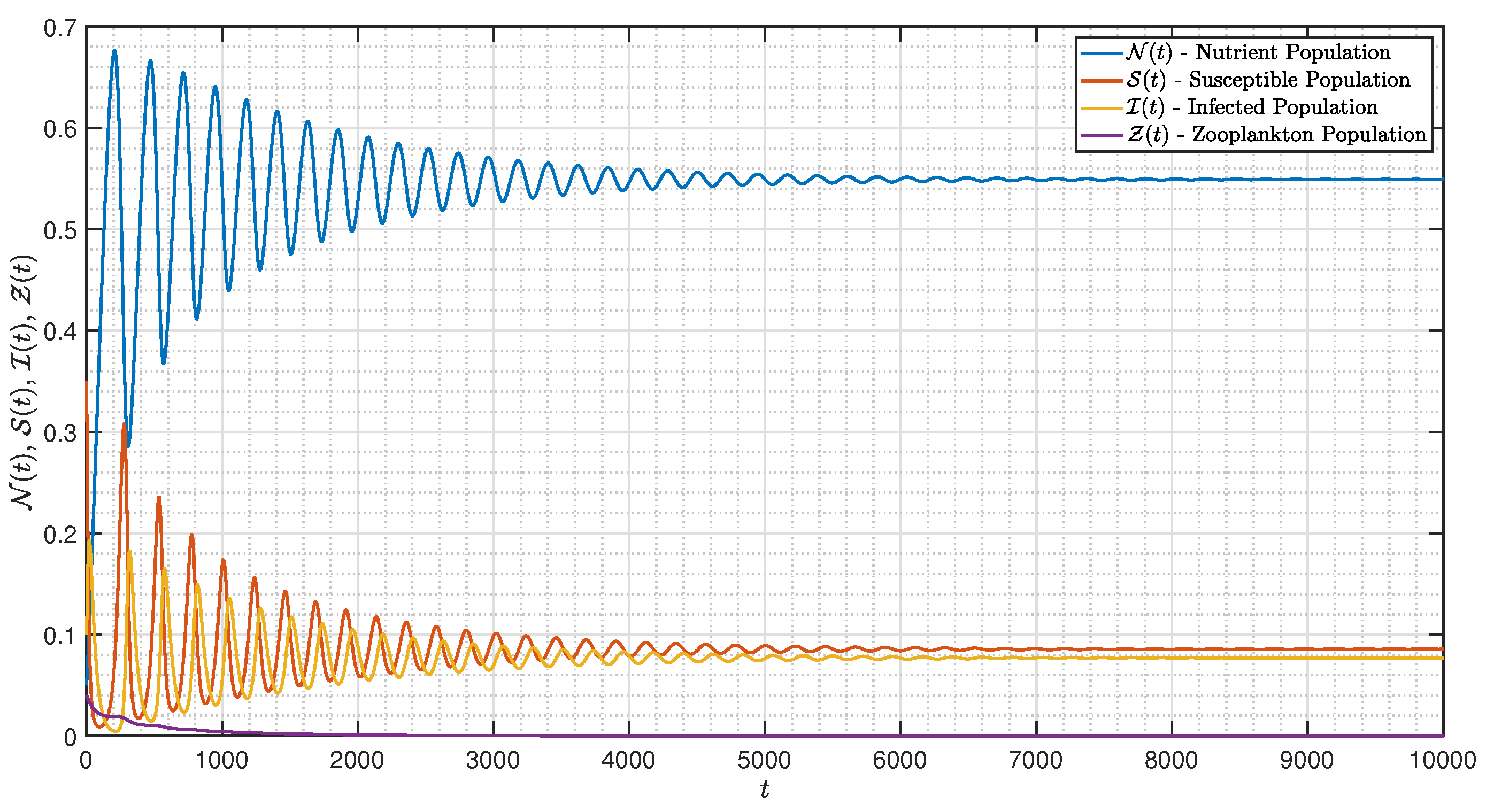



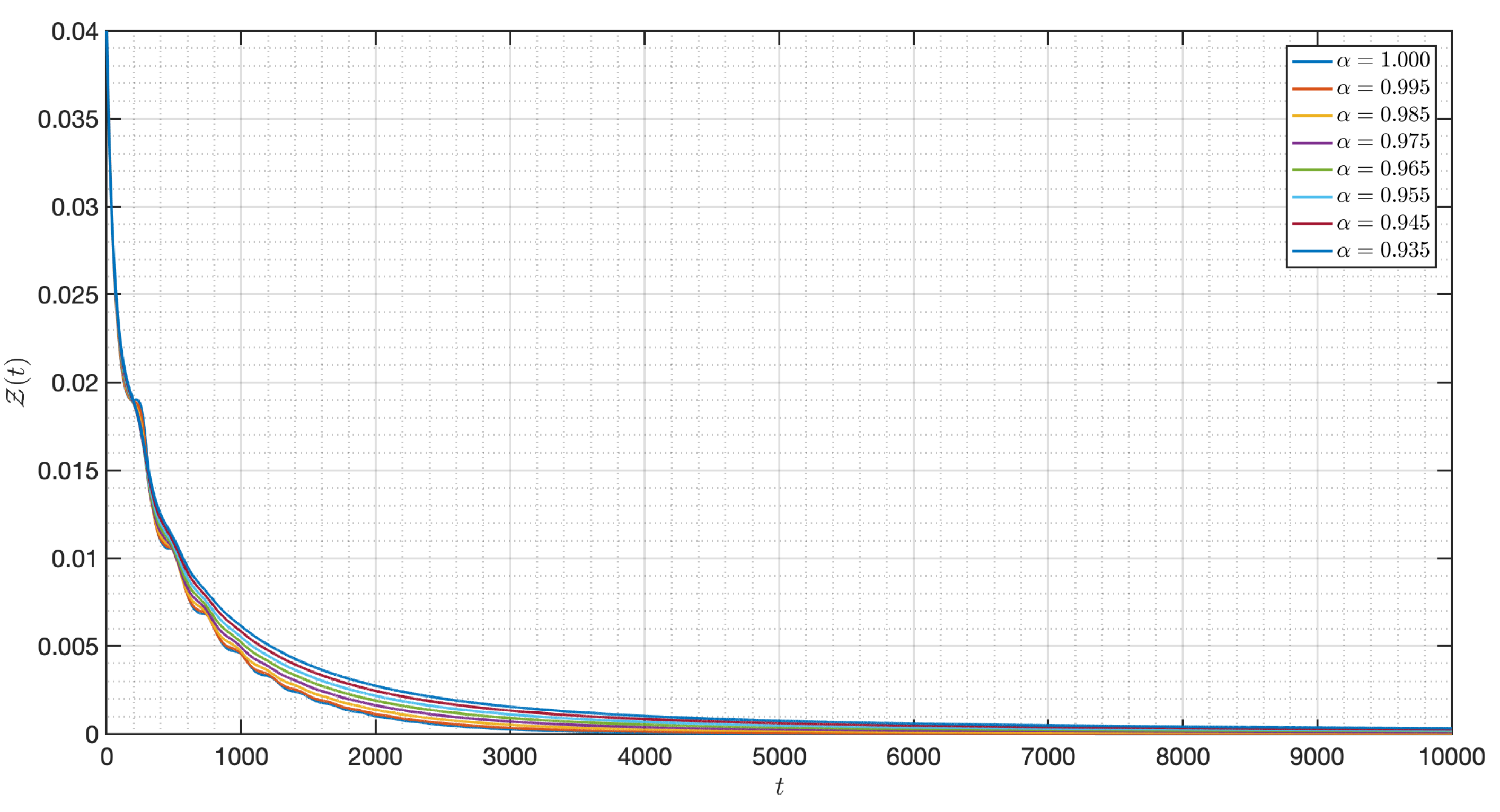




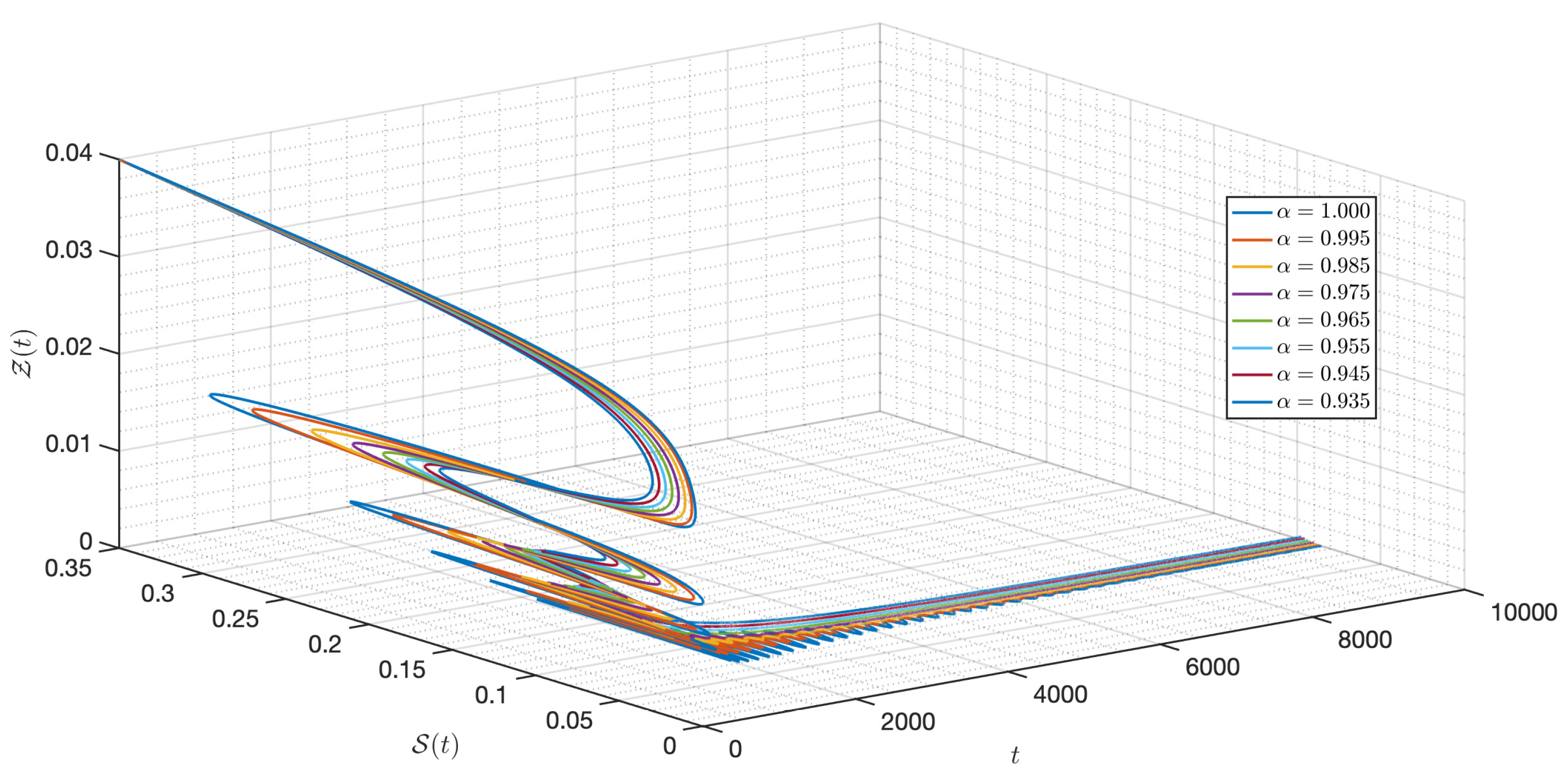


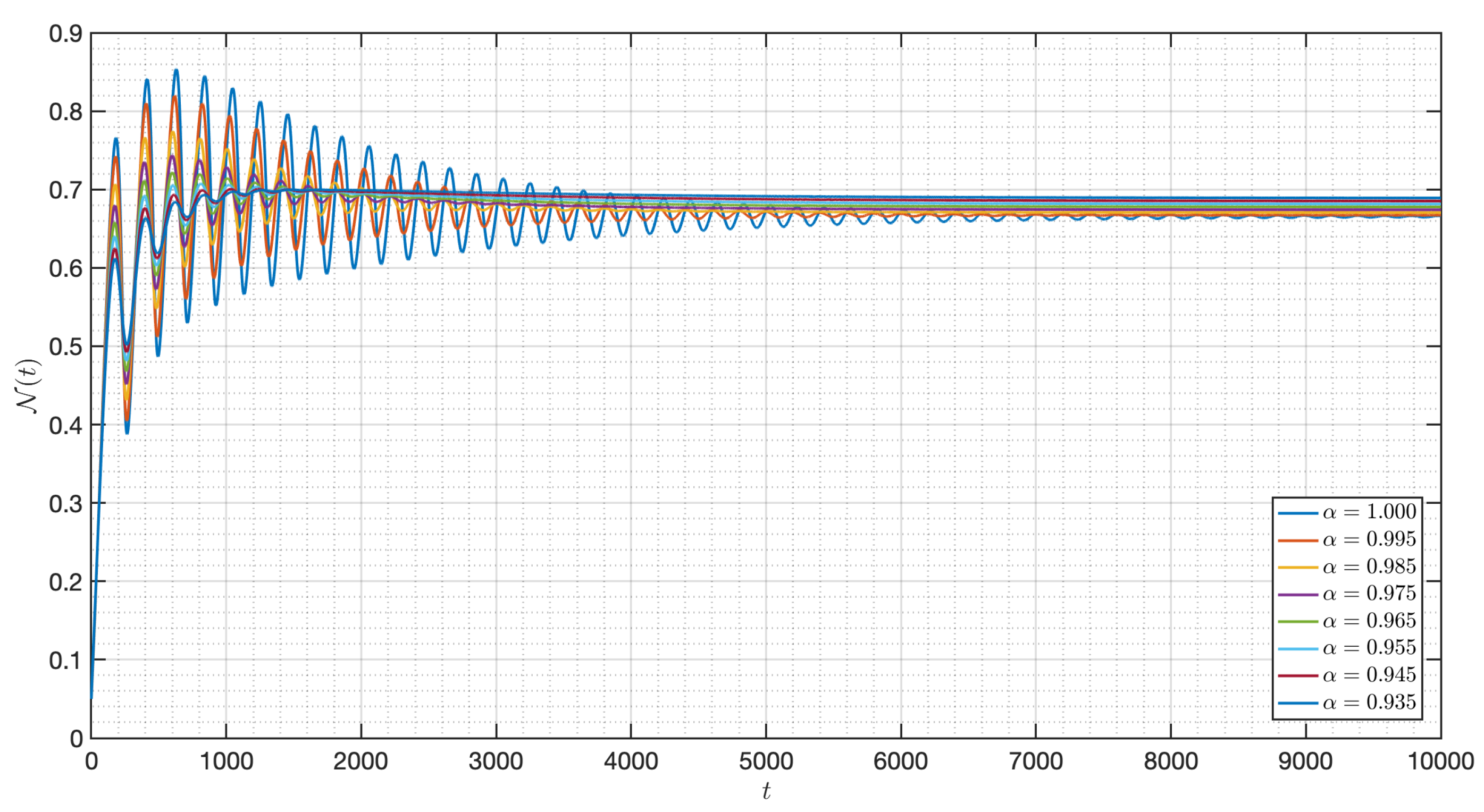







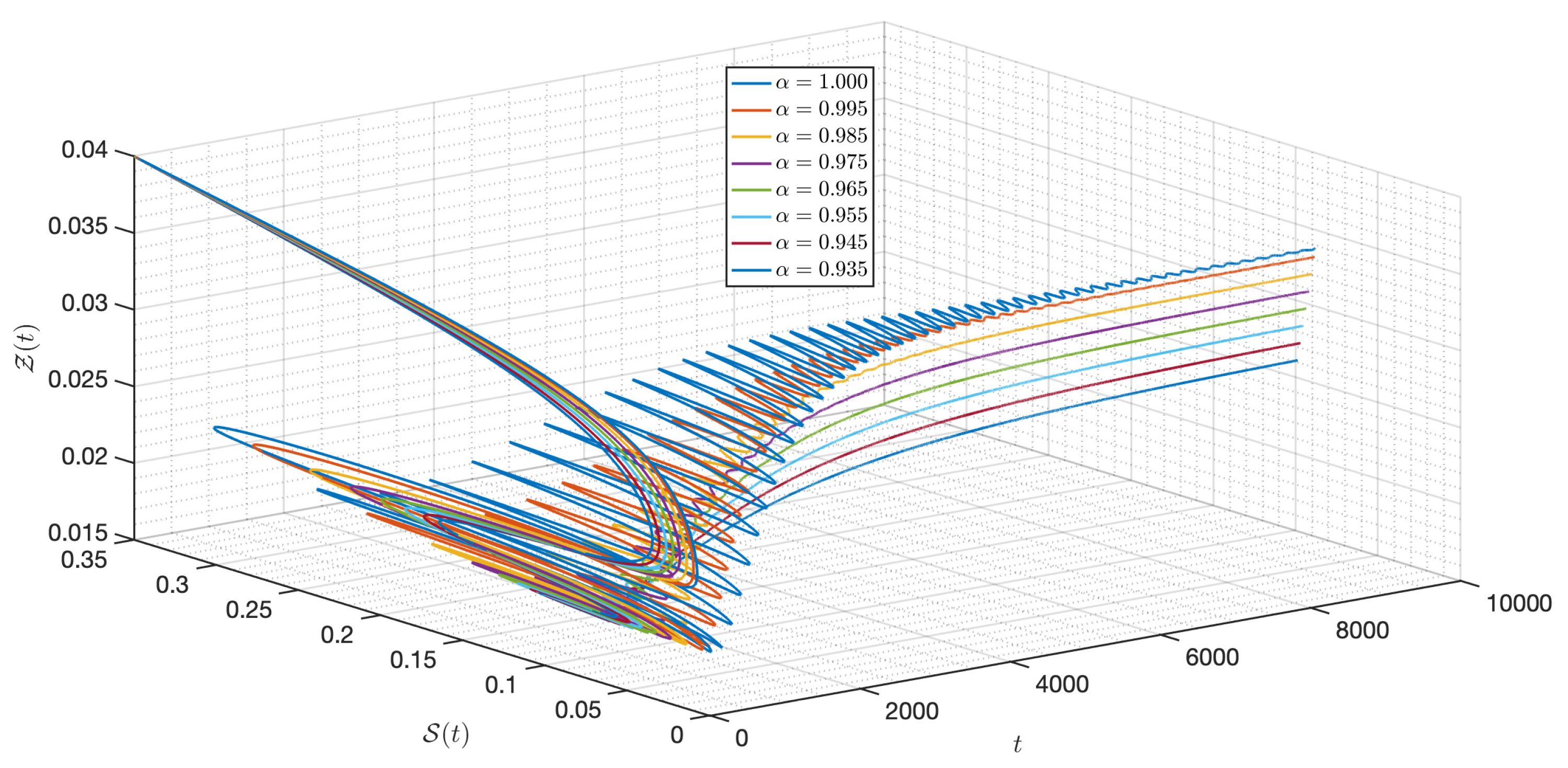


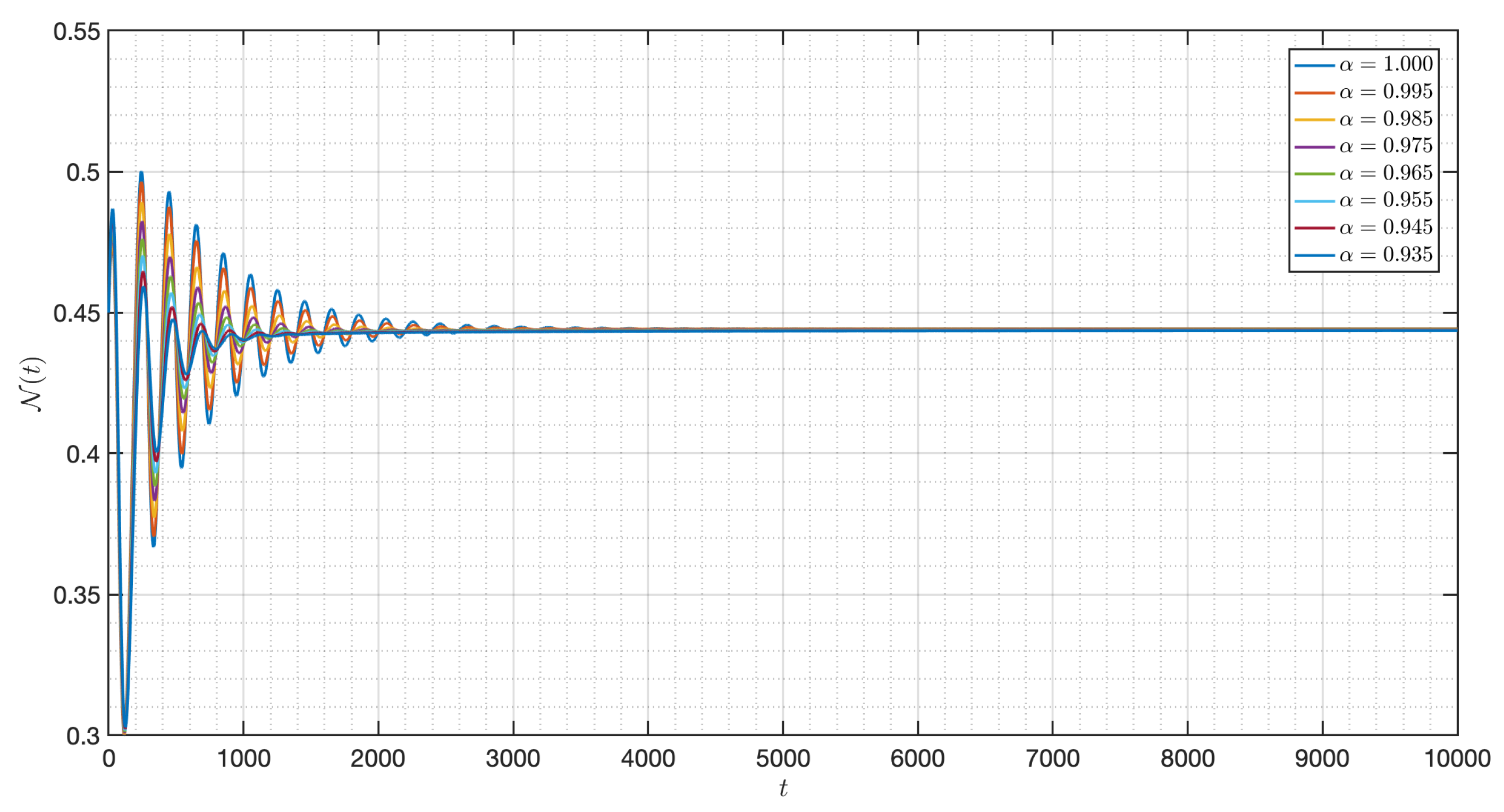





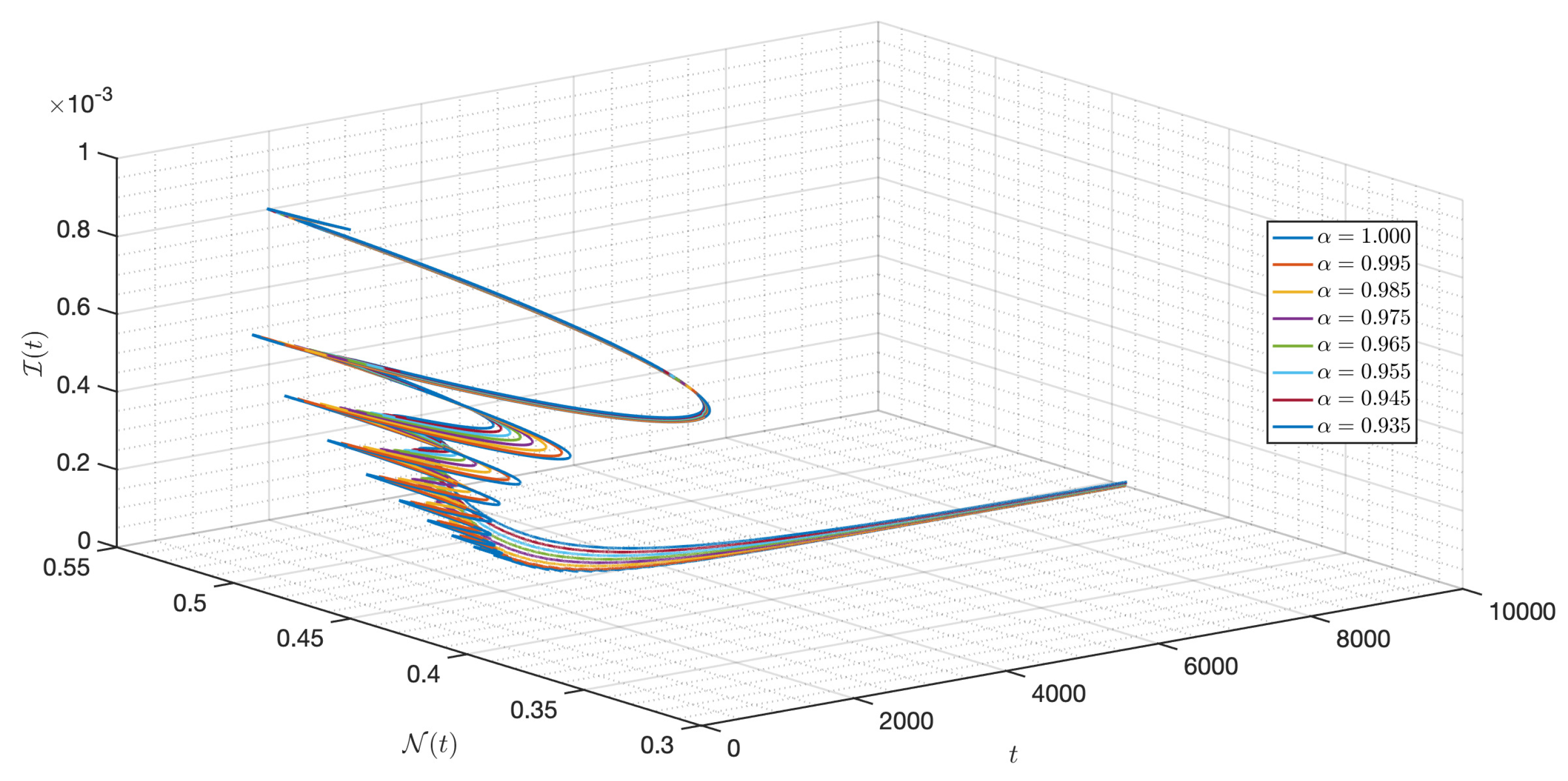


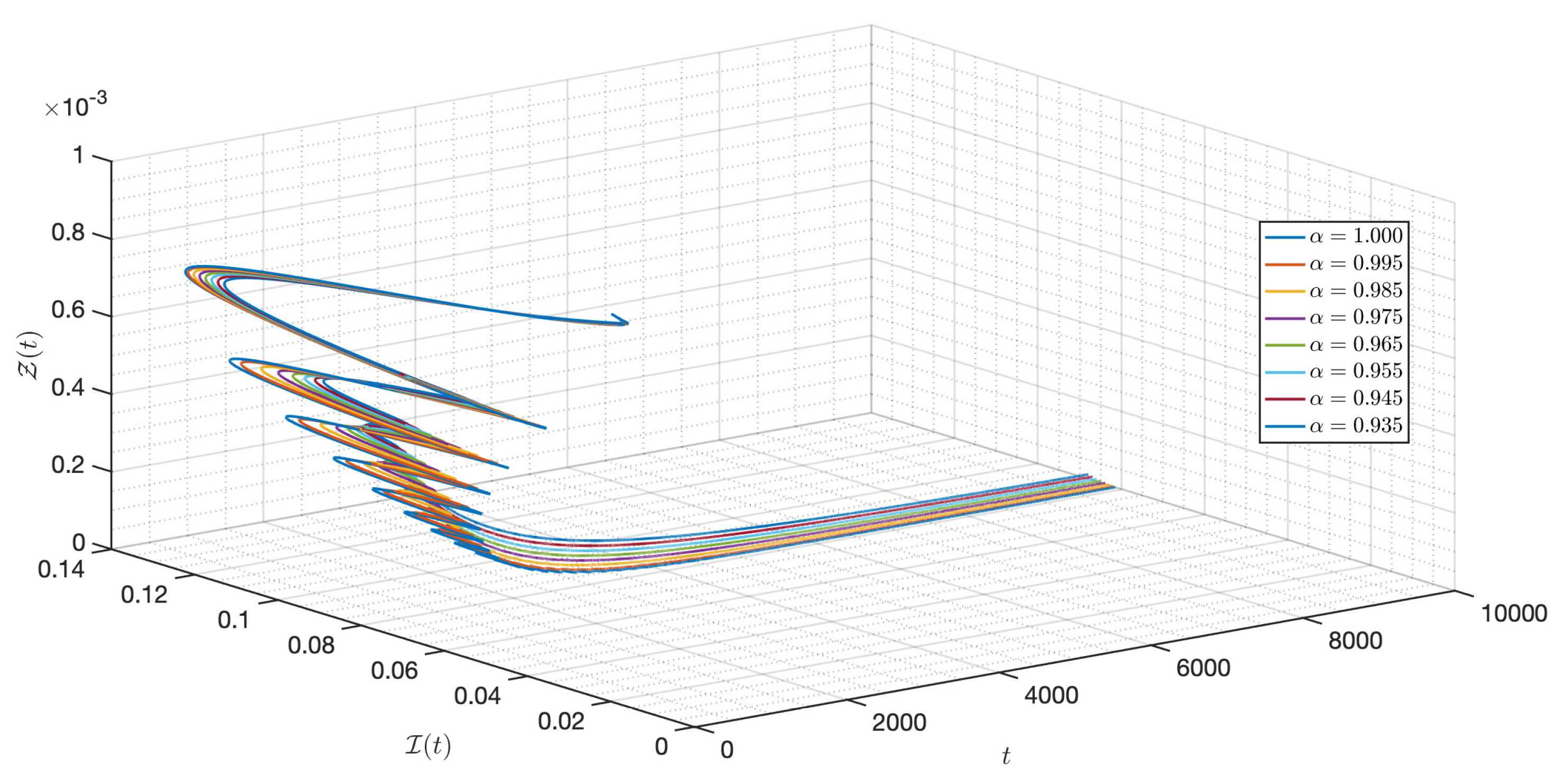

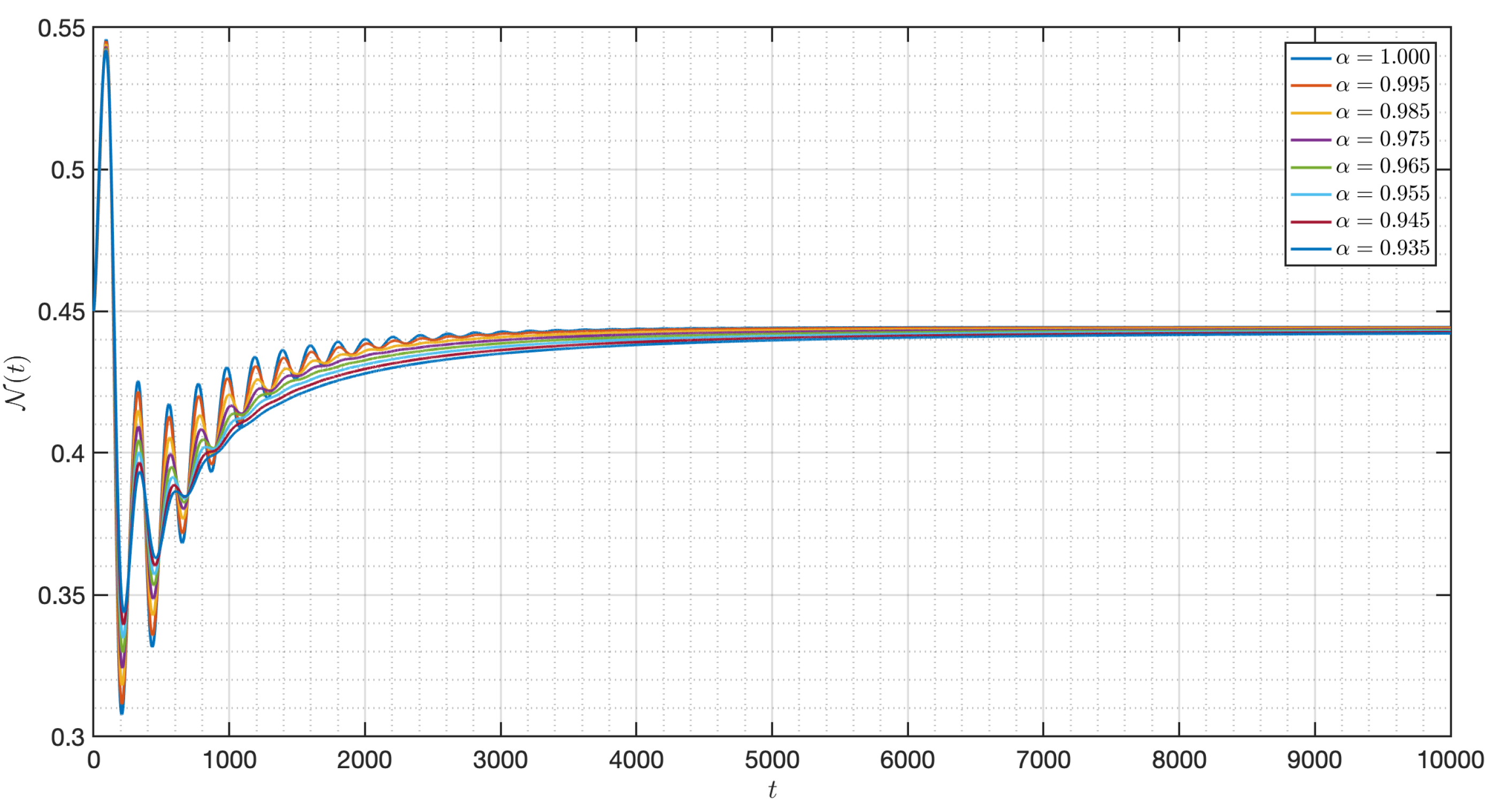

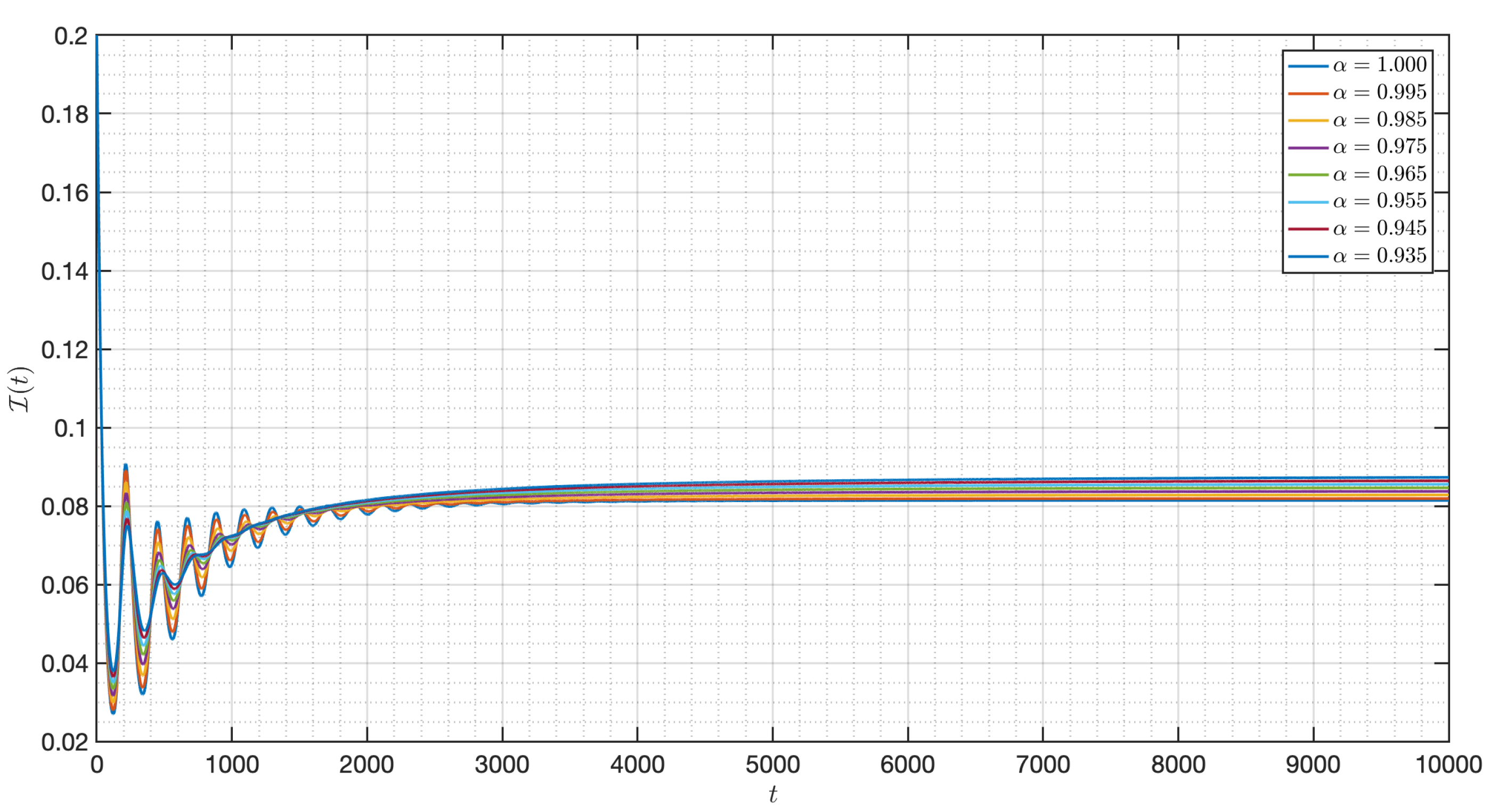

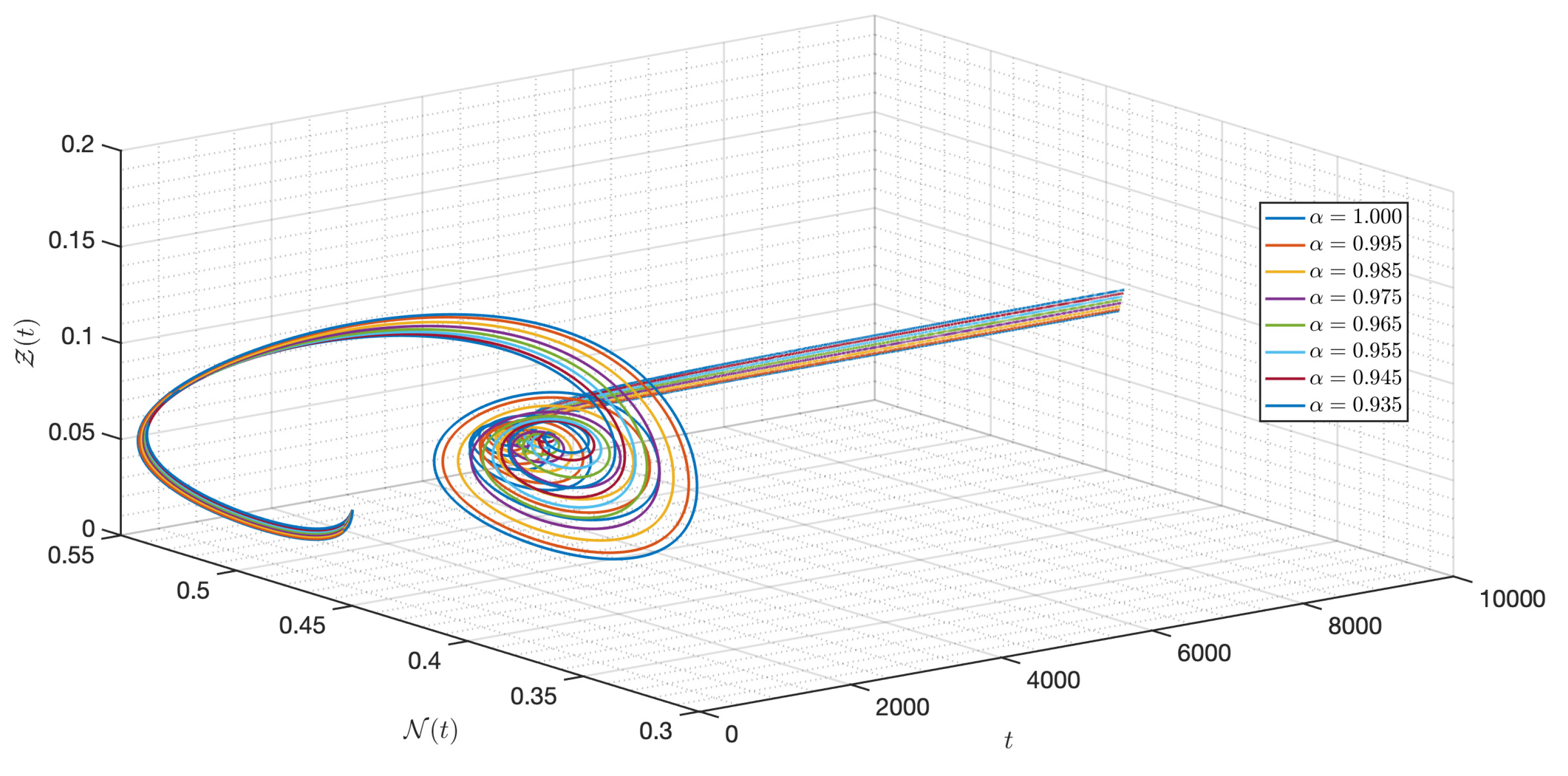




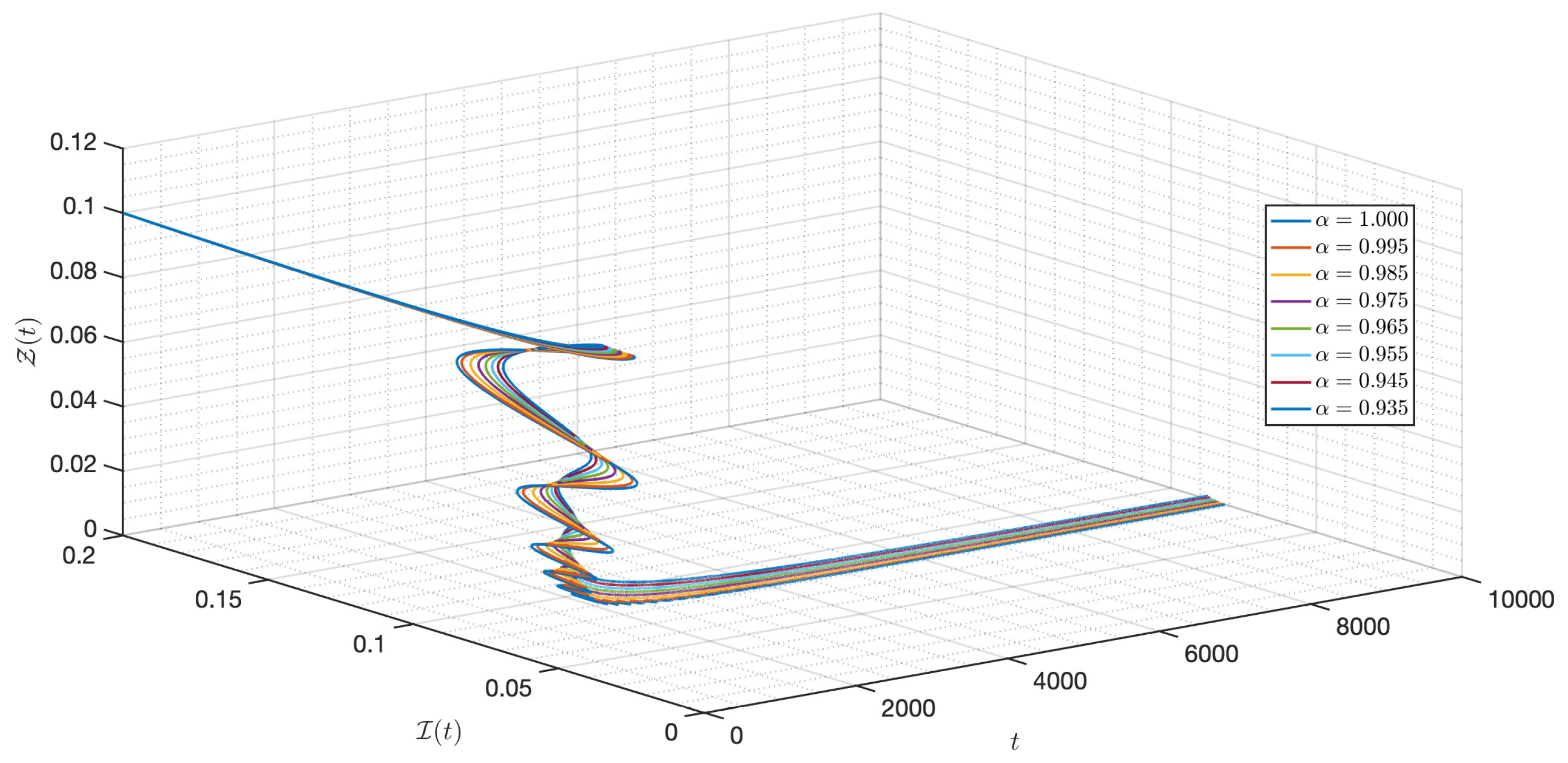
| Parameter | Details of the Parameter |
|---|---|
| The constant input of nutrient concentration; | |
| The washout rate of the nutrient; | |
| The mortality rate of susceptible phytoplankton group; | |
| The mortality rate of infected phytoplankton group; | |
| The mortality rate of zooplankton group; | |
| a | The maximal intake nutrient rate for susceptible phytoplankton species; |
| b | The maximal intake nutrient rate for infected phytoplankton species; |
| c | The maximal intake nutrient rate for zooplankton species; |
| The force of infection between the both phytoplankton groups; | |
| m | The predation rate of zooplankton for susceptible phytoplankton; |
| n | The predation rate of zooplankton for infected phytoplankton; |
| The conversion efficiency due to consumption of susceptible | |
| phytoplankton; | |
| The conversion efficiency due to consumption of infected phytoplankton; |
Publisher’s Note: MDPI stays neutral with regard to jurisdictional claims in published maps and institutional affiliations. |
© 2022 by the authors. Licensee MDPI, Basel, Switzerland. This article is an open access article distributed under the terms and conditions of the Creative Commons Attribution (CC BY) license (https://creativecommons.org/licenses/by/4.0/).
Share and Cite
Pleumpreedaporn, S.; Pleumpreedaporn, C.; Kongson, J.; Thaiprayoon, C.; Alzabut, J.; Sudsutad, W. Dynamical Analysis of Nutrient-Phytoplankton-Zooplankton Model with Viral Disease in Phytoplankton Species under Atangana-Baleanu-Caputo Derivative. Mathematics 2022, 10, 1578. https://doi.org/10.3390/math10091578
Pleumpreedaporn S, Pleumpreedaporn C, Kongson J, Thaiprayoon C, Alzabut J, Sudsutad W. Dynamical Analysis of Nutrient-Phytoplankton-Zooplankton Model with Viral Disease in Phytoplankton Species under Atangana-Baleanu-Caputo Derivative. Mathematics. 2022; 10(9):1578. https://doi.org/10.3390/math10091578
Chicago/Turabian StylePleumpreedaporn, Songkran, Chanidaporn Pleumpreedaporn, Jutarat Kongson, Chatthai Thaiprayoon, Jehad Alzabut, and Weerawat Sudsutad. 2022. "Dynamical Analysis of Nutrient-Phytoplankton-Zooplankton Model with Viral Disease in Phytoplankton Species under Atangana-Baleanu-Caputo Derivative" Mathematics 10, no. 9: 1578. https://doi.org/10.3390/math10091578
APA StylePleumpreedaporn, S., Pleumpreedaporn, C., Kongson, J., Thaiprayoon, C., Alzabut, J., & Sudsutad, W. (2022). Dynamical Analysis of Nutrient-Phytoplankton-Zooplankton Model with Viral Disease in Phytoplankton Species under Atangana-Baleanu-Caputo Derivative. Mathematics, 10(9), 1578. https://doi.org/10.3390/math10091578








